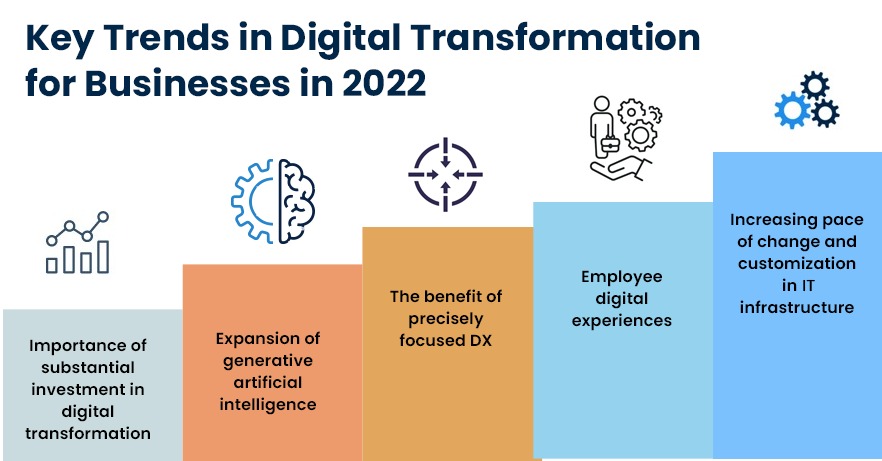
Inside this Article
ToggleEveryone is talking about digital transformation, it is not just a buzzword but a modern reality. In the business environment, we have seen an ever-increasing number of applications and digital products that aim to make existing services more efficient. Such an ecosystem only points to a demand for digital-first technologies. Businesses that have begun their digital transformation journey are finding exciting results from its implementation.
The Challenges of Digital Transformation
Yet in many cases, most organizations find themselves lagging behind their competitors because of a delay to bring in digital innovation. It is one of the biggest business threats for those who have yet to embrace changing needs. The challenges businesses face in crafting a digital transformation strategy are three-fold. Digital innovation requires a culture of embracing change, experimentation and continual learning and organizations might not be ready for such an upheaval.
Overcoming the Roadblocks in Digital Transformation
Many businesses do understand the need to stay ahead of the competition using the leverage that digital technologies can provide them. However, they are stuck in the drawing-board stage.
Building a Vision for Digital Transformation
How can businesses go beyond these hurdles and accelerate their digital transformation? The answer lies in building a vision for the future and then evaluating technologies and building human skill sets to achieve it.
Digital Transformation vs. Digitization
It is apparent that technology is not a good to have but an imperative for every industry. In this perspective, the difference between digital transformation and digitization should be clearly understood. An billion dollar organization might implement an isolated project as part of its digitization effort (and this is the category many businesses come under). However, when digital transformation is the goal, then the project will span multiple departments with a digital first mindset. It will focus on evaluating systems and services and then deciding which processes can be not just digitized but also automated to bring in overall improvements. Digitization then is a part of the digital transformation process.
Understanding the Difference with an Example
To explain Digital transformation vs. Digitization here is an example – scanning of emails or paper documents to convert them into digital documents that can be stored as retrievable data for added business value. That is what digitization is, the use of technology and digital data to improve existing business processes.
Example of Digital Transformation
An example of digital transformation can be seen in the way Farmers Insurance, a leading American insurance provider is using drones to conduct a risk assessment for policy premium evaluation as well as in claims management. These drones are connected to the company’s policy management and claims management systems via cloud computing. Since they use the Internet of Things technology (IoT devices), they are able to transmit real-time data and images making for faster assessment time. IoT devices are smartphones, smart watches, fitness trackers, drones, smart security systems, etc. As you can see, the end product of digital transformation is often a customer-centric strategy that spans diverse departments, employees and processes.

A 3-Step Digital Transformation Roadmap for Billion-Dollar Organization
No industry is immune to the threat of being left behind. Digital transformation in 2022 is a rule and not an exception. For instance, just take yourself back to a decade ago. If you needed to invest, you either went to a financial firm or to your bank. In 2014, an online investment start-up became a trailblazer making investment a cheaper and faster process. All financial firms had to scramble to transform themselves. Now, from banking services to eshopping, the way we interact has completely changed.
Digital transformation is not an overnight change. Every business needs an internal champion to spearhead the digital transformation process and then come up with a plan to take it off the drawing boards and into reality. From iTech’s experience working with million dollar businesses in their digital transformation journey, it is recommended to break this process down into 3 steps to make it more manageable.
Step 1. Analyze your product/service offerings and the processes that support it
Take a step back and look at your business from an eagle eye view. Look at how you want to deliver your products and services in the future and what possible disruptions in your service model by competitors could scare you. Don’t bother with budgets, feasibility or any other challenges at this stage. Just consider what possible innovations your organization should be looking at in the current situation that would power your future growth into billion dollar organization.
Don’t bother with budgets, feasibility or any other challenges at this stage.
In this context, the best example to illustrate how this works is in the transformation of a well known brand, Adobe, an American software company. Almost every business has used at least one of its products. – Adobe Photoshop, Adobe Illustrator, Adobe Acrobat Reader. In 2008, Adobe Systems (as it was then called) was hit by the global economic slowdown. In such a critical situation, they took the difficult decision to change from a license model to a subscription-based model. To do that they had to change from the physical boxed systems they sold and become a Cloud Company that today operates a very successful SaaS model (Software as a Service). To make this change they also had to retain the best talent. They did this by investing in employee-focused work culture and benefits.
The Adobe example strengthens the fact that digital transformation occurs on many levels. It has to happen right across the organization and redefine the way things are done for everyone. – not just employees but also customers.
Step 2. Do a gap analysis
Organizations are constantly innovating, restructuring, and transforming themselves. Mostly this is usually ad hoc, reactive and limited in scope. In the case of a digital transformation strategy, there is a more holistic approach to tap into the full potential. A gap analysis is an essential second phase of digital innovation.
If your current position is considered as Point A, consider Point B as the point your organization wants to get to. The difference between these two is the gap to be bridged.
If your current position is considered as Point A, consider Point B as the point your organization wants to get to. The difference between these two is the gap to be bridged. It looks into back-office functions to front-office operations, includes the ecosystems of partners, vendors and stakeholders and evaluates the gaps and leaks everywhere. Solving a challenge is first acknowledging that existing processes are not going to get your company to where it wants to go.
Once the gap analysis is done, often with the help of consultants, the next stage is to determine what steps must be taken in a multi-phased manner to reach the business goal. In this part of the planning stage, businesses will require to look at budgeting that covers the in-house capacity and new hires, possible outsourced functions and technology investments. Digital transformation technologies like AI, machine learning, natural language processing, automation and the Internet of Things could be part of the plan. In fact, AI Chatbots are an active trend in 2022 to improve customer service. These are the disruptive technologies that all or in part are fueling digital innovation.
Step 3. Implementing the plan
This does not mean scrapping the old at one go and bringing in the new. While digital transformation provides a great opportunity for core business functions to move from manual processes to automation, these productivity improvements will need to have been prioritized at the planning stage. It is always good to select a team that will test drive the initial changes before increasing the pace of transformation. Once you see what works, you will know where to focus energy.
The Role of Big Data in Digital Transformation
In any digital transformation strategy, businesses will need to take advantage of big data. Organizations have access to larger volumes of data than ever before and this is mostly due to the Internet of Things. With the right set of analytical tools, this data can be converted into valuable business insights to make quicker, better-informed decisions.
Digital Transformation is Ongoing
Remember though, that digital transformation is continuous with no cut-off date. Organizations will need to continually evaluate their new organizational processes and pivot where necessary.
Partnering with iTech for Digital Transformation
Partnering with iTech: Businesses have leveraged our years of experience, strong domain knowledge, IT expertise and digital fluency to realize their digital transformation strategy. Each organization and ecosystem will differ and solutions will need to be customized.
With change comes new opportunities and It is a new and exciting time for businesses with the number of technologies available to streamline processes. Talk to our team of experts to know how we can work with you on your digital strategy.




